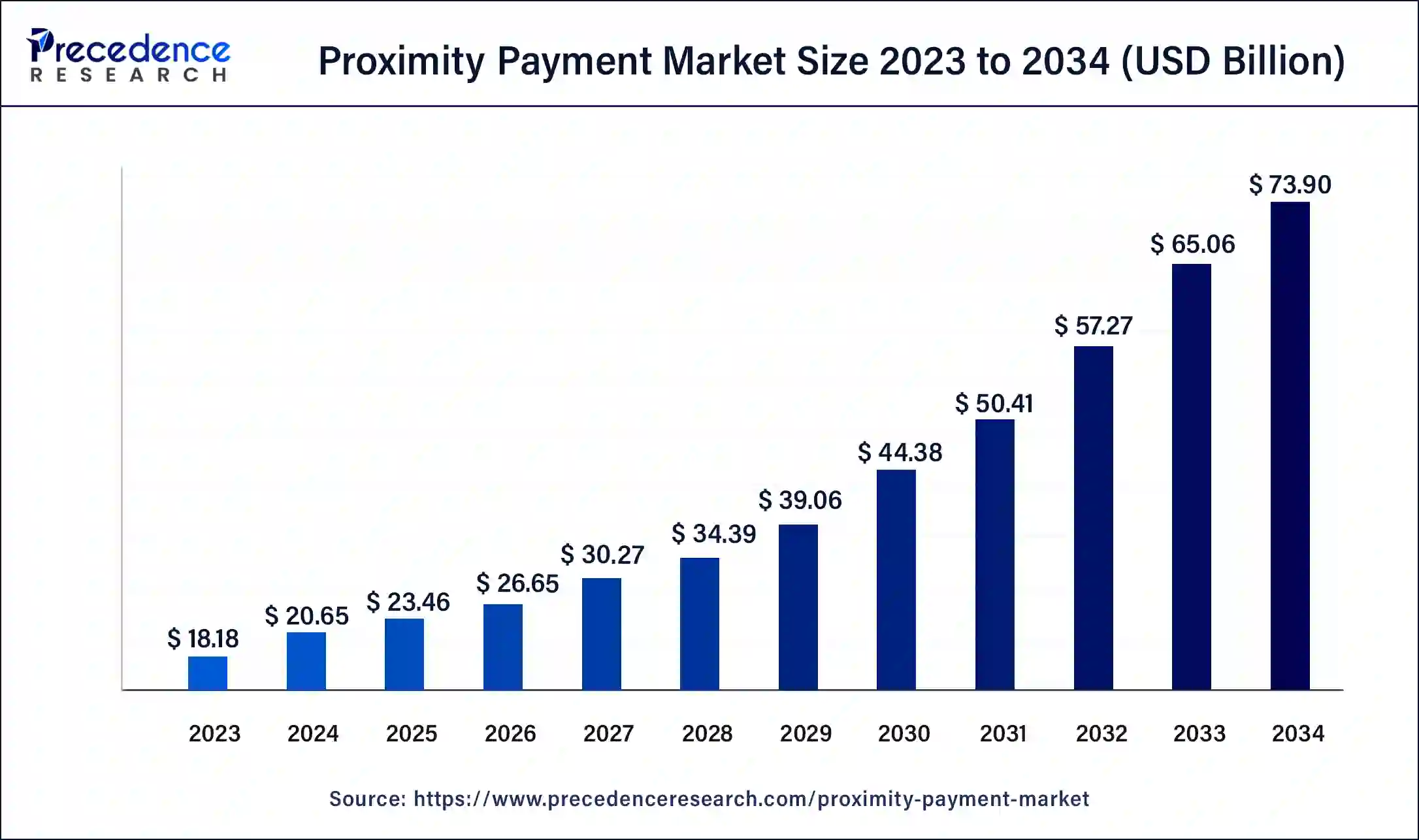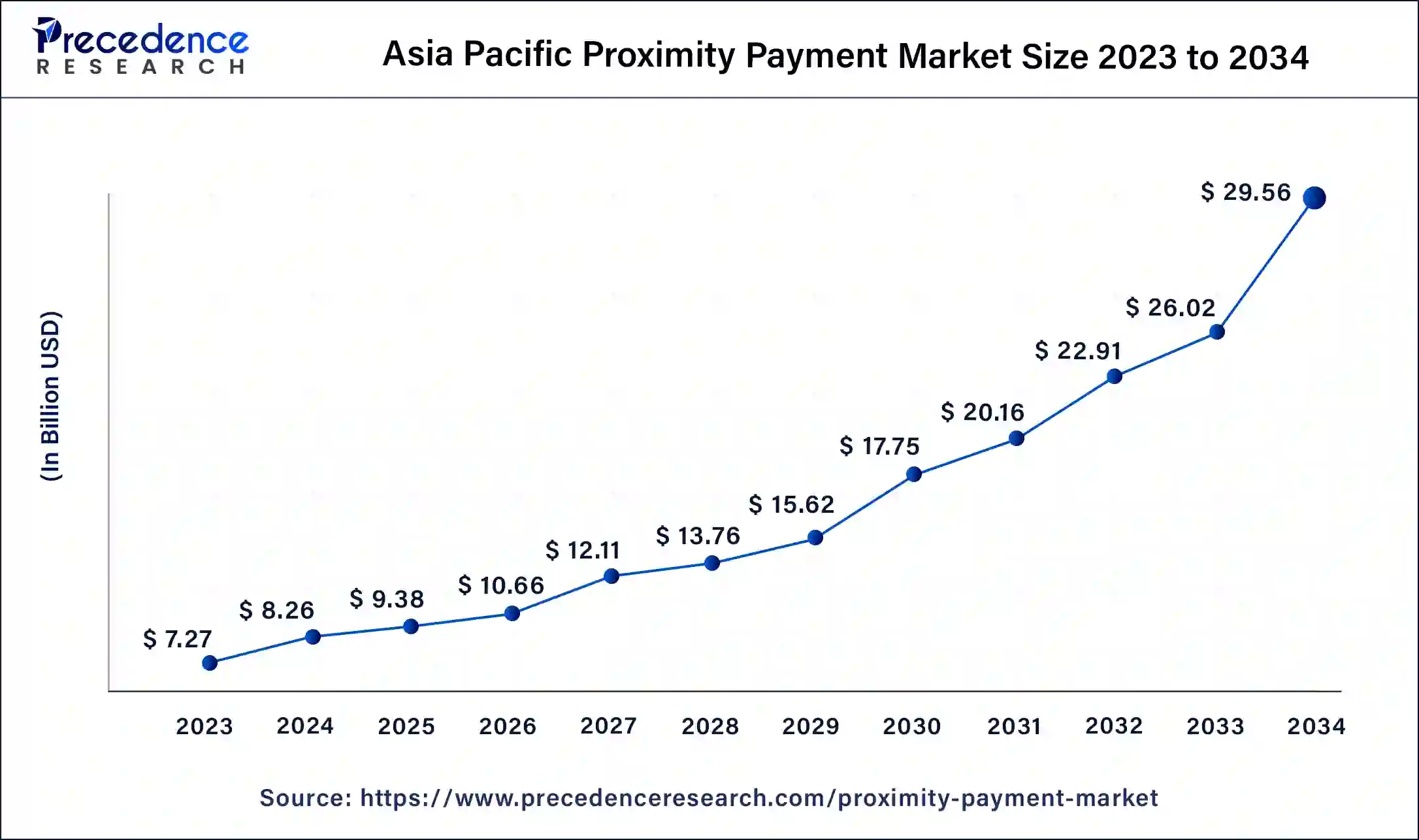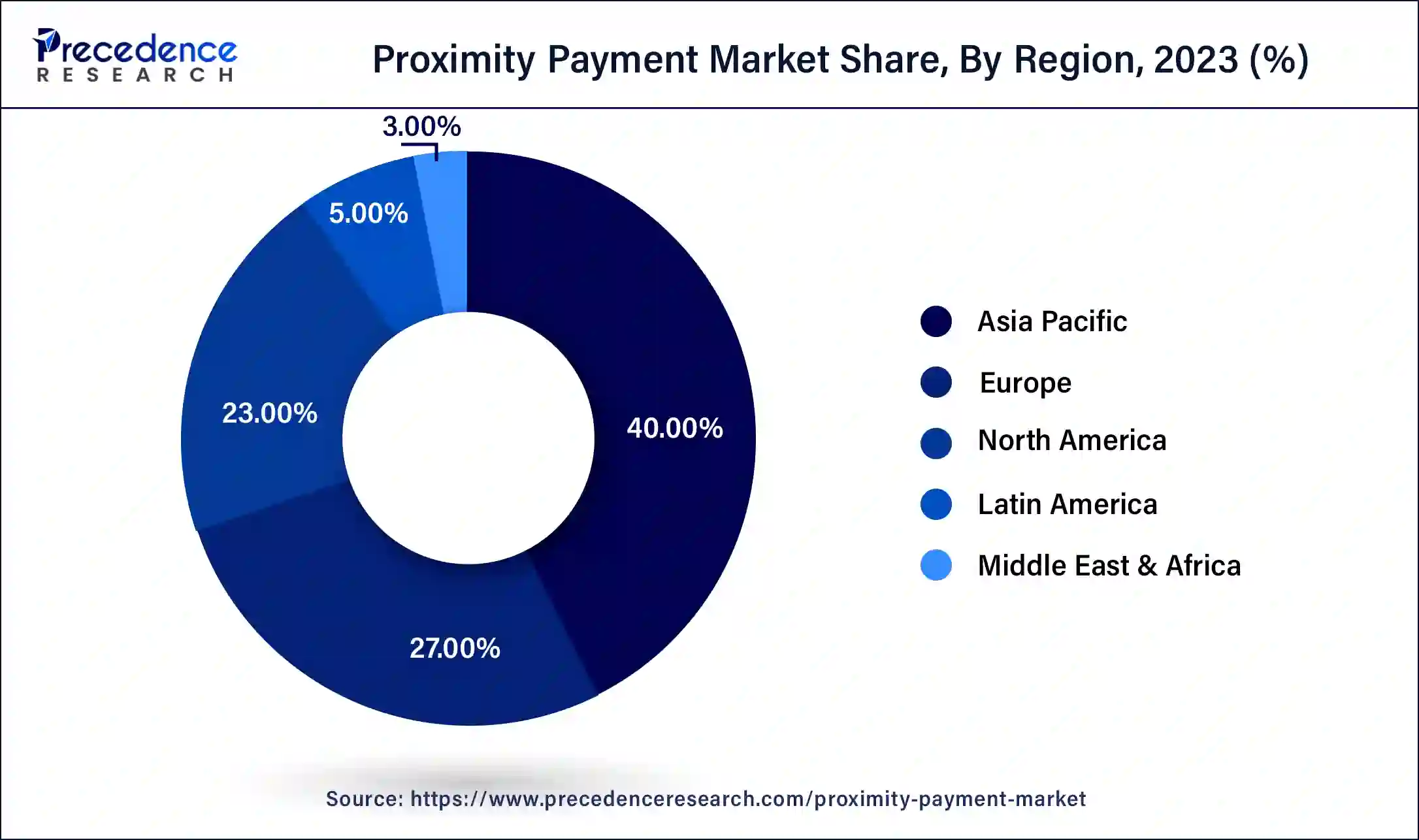February 2025
The global proximity payment market size was USD 18.18 billion in 2023, calculated at USD 20.65 billion in 2024 and is expected to reach around USD 73.90 billion by 2034, expanding at a CAGR of 13.6% from 2024 to 2034.
The global proximity payment market size accounted for USD 20.65 billion in 2024 and is expected to reach around USD 73.90 billion by 2034, expanding at a CAGR of 13.6% from 2024 to 2034.

The Asia Pacific proximity payment market size was estimated at USD 7.27 billion in 2023 and is predicted to be worth around USD 29.56 billion by 2034, at a CAGR of 6.5% from 2024 to 2034.

Asia Pacific region is expected to dominate the proximity payment during the forecast period owing to presence of developing nation such as India, China, South Korea, Japan and Australia. These countries provide a stable ecosystem that fosters the growth of the proximity payment market. In India, the act of demonetization has opened up huge opportunities for the digital payments. According to Visa Inc. in India the proximity payments accounts to more than 25% of the total transaction happening in the country. For instance, on 25th August 2021, Against all obstacles, CCAvenue, a prominent digital payment platform, functions admirably and regularly. Despite the challenging regulatory climate and dynamic nature of the industry, it continues to succeed in its business endeavours. CCAvenue was honoured with the 'Best Technology Solution for Enterprise Risk Management' award at the Innovation & Technology Awards 2021, which were co-hosted by Inkspell and Global Trends Forum. Also, countries like Australia are evolving at a faster rate in terms of adopting proximity payments. According to Visa Inc. 79% of the total transaction took place electronically leaving only 21% transaction to be carried out by cash.

Europe on the other hand is dominating the proximity payment market owing to the increased awareness among the users regarding the benefits of proximity payments and the Government policies that favors the implementation of hassle free and safe proximity payment systems.For instance, on 24th June 2021 Visa Inc., the world's largest digital payments company, has announced the signing of a definitive agreement to buy Tink, Visa will pay a total financial consideration of 1.8 billion Euros, which includes cash and retention incentives.
The major benefits that is provided by the proximity payment systems include flexibility of payment devices, reduced transaction time, Real-time transaction processing and increase in convenience. All these factors are expected to drive the growth of the market. Moreover, the massive adoptions of proximity payments among the merchants and the surge in the usage of the Smartphone that facilitate the proximity payments are some of the attributes that contributes significantly towards the market growth. For instance, On 24th June 2021, FIS, a financial technology pioneer, announced that USALLIANCE Financial, based in Rye, New York, has chosen the FIS Payments One platform to streamline and modernize its credit and debit card digital payment options for its members. Payments from the FIS One platform combines credit and debit card processing, loyalty, fraud protection, and card manufacturing into a single programmed. This will help USALLIANCE Financial to benefits form the robust capabilities of FIS’ Payments One to streamline and modernize its portfolio of card offerings.
The surge in the faster connectivity has motivated the customers and the merchants to execute proximity payments and this factor drive the growth of the market. The developing countries offer wide range of opportunities for the market growth owing to the growth of middle class segment, rise in literacy level, rapid urbanization and others. Furthermore, the Government initiative to promote the digital payments in order to eliminate the money laundering activities is expected to boost the growth of the proximity payment market.
The increasing payment efficiency and the customer convenience with reducing operational cost are some of the factors that drive the market growth. The adoption of proximity payments will reduce the paper based transaction and hence it is considered as a good green initiative. Additionally, with the rapid urbanization the smartphones have become an essential commodity in the life of an individual and thus this increased penetration of smartphones in the lives of the customers has fueled the growth of the proximity payment market.
In the post-pandemic era, the contactless payments have become one of the primary factors contributing significantly towards the market growth. Furthermore, the Government across the globe is promoting the digital payments and encouraging banks to build robust payment gateways to secure the proximity payments and this will positively contribute towards the growth of the proximity payment market.
| Report Coverage | Details |
| Market Size by 2034 | USD 73.90 Billion |
| Market Size in 2023 | USD 18.18 Billion |
| Market Size in 2024 | USD 20.65 Billion |
| Growth Rate from 2024 to 2034 | CAGR of 13.6% |
| Largest Market | Asia Pacific |
| Fastest Growing Market | Europe |
| Base Year | 2023 |
| Forecast Period | 2024 to 2034 |
| Segments Covered | Offering, Application, Regions |
| Regions Covered | Asia Pacific, North America, Europe, Latin America, Middle East and Africa |
Based on the Offering, the Proximity Payment Market is divided into Solution and Service. The solution segment in the offerings will hold the largest market share in 2023 accounting for more than three fourth of the total share and is expected to dominate the market during the forecast period. Owing to the data breaches in the proximity payments, robust infrastructure should be built that provides a safe payment infrastructure and therefore this segment is continuously under research and development to produce the safe environment for the payment and this factor is expected to contribute positively towards the growth of the proximity market.
The service segment is also projected to grow at fastest rate of 14.8% CAGR during the forecast period owing to the increased penetration of the mobile phone in the lives of the customers and the convenience with which the proximity payments are carried on.
Based on the Application, the Proximity Payment Market is divided Grocery Stores, Bars & Restaurants, Drug Stores, Entertainment Centers and Others. In this segment, the grocery store is estimated to hold the largest share accounting for more than one third of the global proximity payments. The availability of payment infrastructure at different places facilitates the proximity payments. For instance, On 6th October 2021, Paypal introduced PayPal QR Codes as Inflight Payment Option offering customers buy snacks, drinks, and other inflight purchases while on board by just scanning a QR code – with or without Wi-Fi. Therefore, the use of proximity payment systems provides hassle free contactless payments to its users. This robust payment infrastructure has huge opportunities to grow in the upcoming years owing to the benefits it provides.
The bars and restaurants are anticipated to grow significantly in the upcoming years owing to convenience with which the payment are carries out.
Segments Covered in the Report
By Offering
By Application
By Geography
For inquiries regarding discounts, bulk purchases, or customization requests, please contact us at sales@precedenceresearch.com
No cookie-cutter, only authentic analysis – take the 1st step to become a Precedence Research client
February 2025
December 2024
January 2025
December 2024